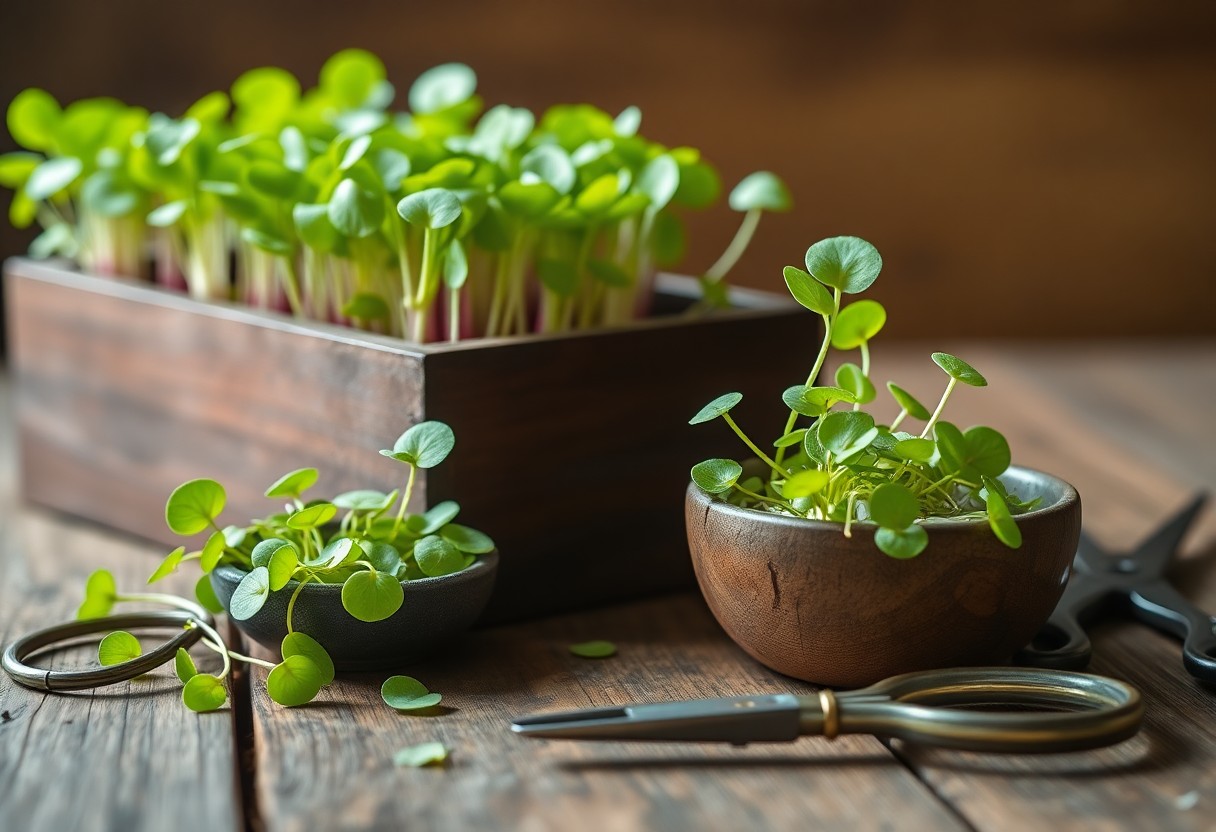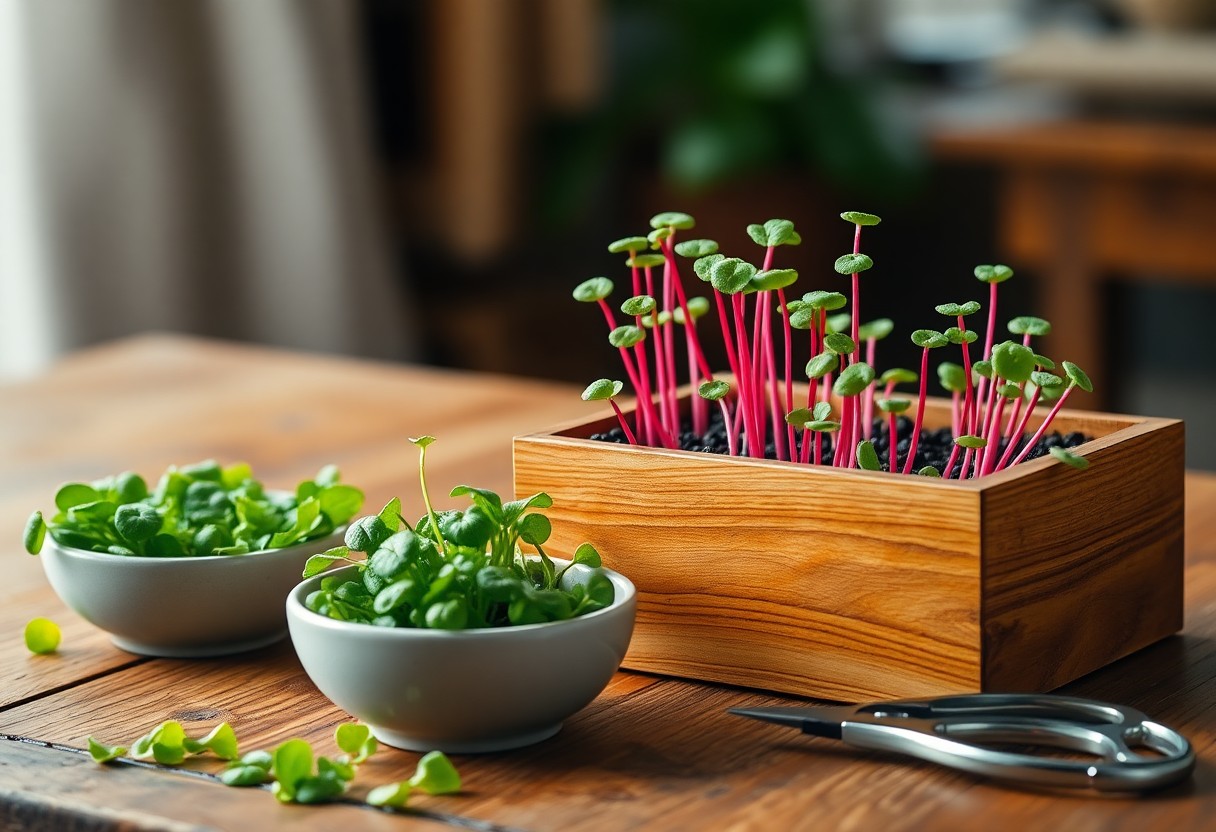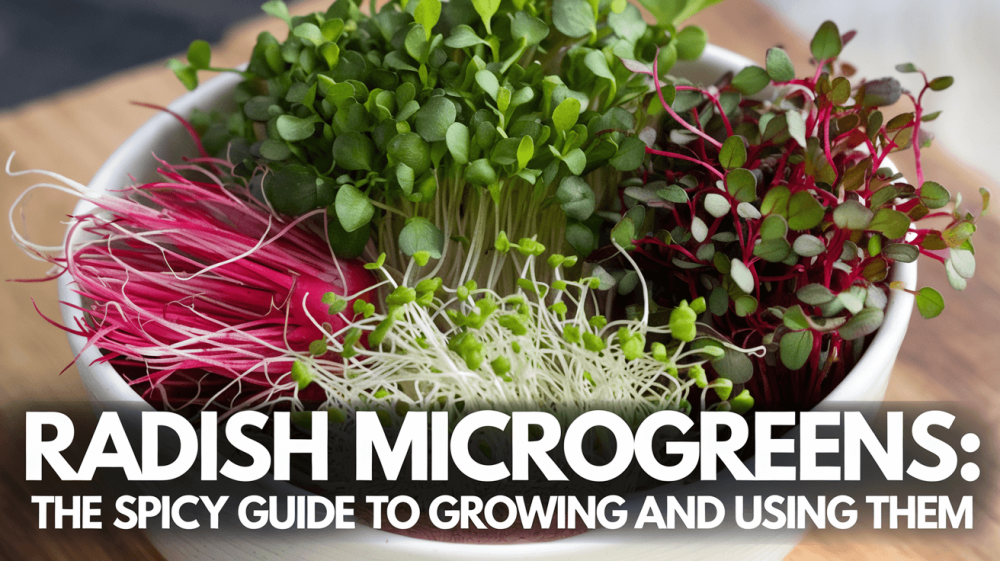This guide invites readers to discover the exciting world of radish microgreens.
He, she, or they will learn how to effortlessly grow these zesty plants right at home, transforming any dish with their delightful crunch and peppery flavor.
With step-by-step instructions and tips on the best methods, they’ll find that cultivating radish microgreens is both rewarding and fun.
Additionally, they’ll uncover various ways to incorporate these vibrant greens into meals, adding not just taste but also nutritional benefits to their diet.
Types of Radish Microgreens
To explore the diverse world of radish microgreens, one can find several varieties that bring vibrant flavors and textures to a dish. Some of the most popular types include:
| Variety | Description |
|---|---|
| Red Radish | Offers a classic peppery flavor. |
| Wasabi Radish | Provides a bold, spicy kick. |
| Sakura Radish | Features a mild and slightly sweet taste. |
| Daikon Radish | Has a crisp texture and refreshing flavor. |
| Black Radish | Offers an earthy flavor with a bit of heat. |
Knowing the different varieties can enhance culinary creativity.
Varieties to Choose From
Little did many realize how varied radish microgreens can be, ranging from the common Red Radish to the more exotic Wasabi Radish.
Each type possesses unique properties and flavor intensities, making it easy for anyone to select the perfect microgreen for their dishes.
Flavor Profiles
Some radish microgreens boast a flavor profile that surprises the palate with their vibrant taste ranging from mild to zesty.
Microgreens are known for their concentrated flavors, and radish varieties, in particular, can offer a delightful array of tastes.
The Red Radish brings a classic peppery bite, while the Wasabi Radish delivers an intense spiciness, perfect for thrilling dishes.
In contrast, the Sakura Radish provides milder notes, allowing for versatility in lighter meals. Understanding these profiles helps in selecting the right microgreen to elevate any culinary experience.
Step-by-Step Guide to Growing Radish Microgreens
One can grow delicious and peppery radish microgreens by following these simple steps. By carefully preparing supplies, sowing seeds, and providing the proper environment, he or she can enjoy fresh microgreens in a short amount of time. Below is a structured guide to help with the process:
| Step | Description |
|---|---|
| 1 | Gather necessary supplies including a tray, soil, and radish seeds. |
| 2 | Moisten the soil and fill the tray evenly. |
| 3 | Sow seeds densely, covering them lightly with soil. |
| 4 | Water gently and cover to create humidity. |
| 5 | Remove cover as seedlings emerge and provide light. |
| 6 | Harvest when seedlings are about 1-2 inches tall. |
Preparing Your Supplies
Your first step involves gathering supplies such as a shallow tray, potting mix, radish seeds, and a spray bottle.
It is important to use sterile soil to minimize any risk of disease, and opting for organic seeds can enhance the overall quality of the microgreens.
Having everything organized will make the sowing process smooth and enjoyable.
Sowing and Growing
If they want to start growing their radish microgreens, they should begin by evenly sowing the seeds on a prepared soil surface. Gently press the seeds into the soil and cover them lightly.
Water the seeds with a fine mist to promote germination while avoiding soil displacement. The seeds thrive in bright light, and maintaining moisture is key to ensuring a successful crop.
Microgreens germinate quickly, often sprouting within 3-5 days. They prefer a warm and well-lit environment to flourish.
Regular misting is imperative during the early stages to promote moisture retention, while ensuring they receive adequate light after the cover is removed will prevent weak growth.
He or she should be careful with watering, as over-saturation can lead to mold and disease. With attention and care, harvesting radish microgreens in just two weeks can yield a vibrant and fragrant addition to salads or sandwiches!
Key Factors for Successful Growth
The success of growing radish microgreens relies on several key factors:
- Soil quality – Use nutrient-rich soil for best results.
- Seed selection – Choose high-quality radish seeds to ensure healthy growth.
- Light exposure – Provide sufficient light for optimal photosynthesis.
- Temperature control – Maintain a balanced temperature for healthy growth.
- Water management – Ensure proper watering techniques and drainage.
The right combination of these factors will lead to robust and flavorful radish microgreens.
Light and Temperature
Any successful growth of radish microgreens greatly depends on light and temperature conditions. Here’s a quick overview:
| Aspect | Details |
|---|---|
| Light | Bright, indirect sunlight is best for 12-16 hours daily. |
| Temperature | Maintain a temperature of 70-75°F (21-24°C) for optimal growth. |
Watering and Drainage
While watering radish microgreens, it’s crucial to strike a balance. Over-watering can lead to root rot, while under-watering may hinder growth.
A fine mist is recommended during initial growth, transitioning to more substantial watering as they mature.
Another important aspect of watering is ensuring proper drainage. Radish microgreens thrive best in a well-draining medium, as excess water can suffocate the roots.
She should always check the soil moisture to gauge when to water.
Careful attention to moisture levels will ensure healthy, vibrant microgreens, while neglect may lead to problems like mold growth or weak plants.

Tips and Tricks for Maximizing Yield
Once again, achieving a bountiful harvest of radish microgreens involves paying attention to key factors. He or she can enhance their growth potential by:
- Using quality seeds
- Providing adequate light (12-16 hours per day)
- Maintaining optimal moisture levels
- Choosing the right growing medium
- Ensuring proper air circulation
Recognizing these factors can significantly boost yield quality and quantity.
Harvesting at the Right Time
Now, timing is crucial when harvesting radish microgreens for peak flavor and nutrition. It’s recommended to wait until they have developed 2-4 true leaves, which typically occurs around 7-14 days after germination.
This stage not only ensures vibrant spice but also maximizes their nutritional content.
Preventing Common Issues
With attention to detail, he or she can effectively prevent common problems when growing radish microgreens.
Fungal diseases, such as damping-off, and pests like aphids can be serious issues. Proper sanitation, good airflow, and monitoring moisture levels are important to keep these threats at bay.
Right preparation can mitigate risks and create a thriving environment for radish microgreens. Maintaining good hygiene by sterilizing containers can fend off diseases like damping-off, which can quickly destroy a crop.
Additionally, ensuring that the seeds are not overly saturated with water prevents rot and fosters healthy growth. By keeping an eye on conditions and promptly addressing any issues, he or she will enjoy a successful harvest.
Pros and Cons of Growing Radish Microgreens
Not everyone may realize that growing radish microgreens comes with its unique set of advantages and disadvantages. Evaluating these factors can help aspiring home gardeners make an informed decision.
| Pros | Cons |
|---|---|
| Fast germination (in about 3-7 days) | Requires careful monitoring of moisture levels |
| Rich in nutrients and flavor | Can develop mold if overwatered |
| Easy to grow indoors or outdoors | May be sensitive to light conditions |
| Minimal space requirements | Spicy flavor may not suit everyone’s palate |
| Helps improve soil health if composted | Short shelf life post-harvest |
Benefits of Radish Microgreens
One excellent advantage of radish microgreens is their nutrient density. They are packed with vitamins A, C, and E, along with crucial minerals like calcium and magnesium. Their robust flavor not only enhances dishes but also provides health benefits, making them a favorite among healthy eaters.
Potential Challenges
Now, venturing into the world of radish microgreens isn’t without its challenges. While they are generally easy to grow, certain factors may create hurdles for some gardeners.
Microgreens can be prone to issues like damping-off, a fungal disease leading to seedlings’ rapid decay if conditions aren’t ideal. He or she may find that achieving the right balance of moisture and airflow is tricky.
Additionally, they should be cautious about disturbing the delicate roots when transplanting. Generally, paying attention to growing conditions can help mitigate these challenges, allowing for a successful and rewarding microgreen experience.

Creative Ways to Use Radish Microgreens
Unlike typical salad greens, radish microgreens pack a peppery punch that elevates any dish. They can be sprinkled on sandwiches, added to tacos, or used as a garnish for soups to enhance both flavor and presentation.
Additionally, they make a vibrant addition to smoothies and juices, offering not just taste but also visual appeal. With their striking colors and bold flavor, these microgreens can turn an ordinary meal into a culinary delight.
Culinary Applications
The versatility of radish microgreens allows them to be incorporated into various dishes seamlessly. They can add a zing to fresh salads, serve as a vibrant topping for avocado toast, or be blended into sauces for added zest. Chefs and home cooks alike appreciate their ability to elevate flavors without overwhelming other ingredients.
Nutritional Benefits
Some of the health benefits associated with radish microgreens include their rich content of vitamins A, C, and E, which contribute to overall wellness. They also contain antioxidants that can help combat oxidative stress and inflammation in the body.
It is important to highlight that radish microgreens are not only low in calories but also high in important nutrients. They provide a good source of vitamins and minerals, particularly for those looking to enhance their plant-based diets.
Furthermore, these microgreens contain glucosinolates, compounds known for their potential anti-cancer properties. Incorporating radish microgreens can contribute to a well-rounded diet, offering both flavor and beneficial health attributes.
Final Words
Conclusively, radish microgreens offer a delightful and spicy addition to any dish, making them a favorite among home growers. With the right methods, anyone can successfully cultivate these nutrient-packed greens in their kitchen or garden.
Whether she is adding a zesty kick to salads or he is using them as a vibrant garnish, they provide flavor and color that elevate any meal. Embracing the joys of growing and using radish microgreens adds a fresh touch to their culinary adventures and encourages more exploration in the world of gardening.
FAQ
Q: What are radish microgreens and why should I grow them?
A: Radish microgreens are the young seedlings of radish plants, harvested just after the first leaves have developed.
They are packed with flavor, nutrients, and vibrant color. Growing them is rewarding due to their quick germination time and low maintenance, making them an excellent option for both novice and experienced gardeners looking to add a spicy kick to their meals.
Q: What is the best method to grow radish microgreens indoors?
A: To grow radish microgreens indoors, follow these steps:
1. Choose a shallow tray with drainage holes.
2. Fill the tray with seed-starting mix, leveling it out.
3. Evenly sprinkle radish seeds on the soil surface—aim for a dense coverage without overcrowding.
4. Lightly press the seeds into the soil and mist them with water.
5. Cover the tray with a lid or plastic wrap to create humidity, removing it once seedlings emerge.
6. Place under grow lights or in a sunny window, rotating occasionally for even light.
7. Water as needed to keep the medium moist and harvest the microgreens when they are 1-3 inches tall, typically within 7-14 days.
Q: Do I need special equipment to grow radish microgreens?
A: While you don’t need specialized equipment, a few items can enhance your experience. A seed-starting tray with drainage holes is ideal, along with quality seed-starting mix. Grow lights can be beneficial if natural sunlight is limited. Additionally, a spray bottle for watering and a pair of scissors for harvesting are useful tools.
Q: How can I incorporate radish microgreens into my meals?
A: Radish microgreens can be used in diverse culinary applications. They add a zesty flavor to salads, sandwiches, and wraps. You can also use them as a garnish on soups, tacos, or grain bowls. For a unique twist, blend them into smoothies or use them in pestos. Their vibrant color and spicy taste elevate any dish, making them a versatile ingredient.
Q: Are there any health benefits associated with radish microgreens?
A: Yes, radish microgreens offer numerous health benefits. They’re rich in antioxidants, vitamins A, C, and E, and minerals like calcium and iron. Additionally, they have anti-inflammatory properties and may support digestion. Including radish microgreens in your diet can enhance overall nutritional intake while providing a delightful flavor boost to meals.





